Don't wanna be here? Send us removal request.
Text

Unlock the full potential of your enterprise data with our advanced Power BI solution. Designed for businesses seeking actionable intelligence, real-time dashboards, and data-driven decision-making, our services help you visualize, interpret, and act on data with confidence.
0 notes
Text
Developing Custom Visuals in a Power BI Solution for Industry-Specific Reporting

In today’s fast-paced business environment, standard data visualizations sometimes fall short of conveying the deep, contextual insights companies need. While Power BI offers a robust suite of built-in visuals, industry-specific reporting often demands more than default charts and graphs. This is where developing custom visuals in a Power BI solution becomes a game-changer.
Custom visuals not only enhance data storytelling but also allow organizations to tailor visual outputs to match unique workflows, KPIs, and regulatory needs. Whether you’re in healthcare, manufacturing, logistics, or finance, industry-specific visuals can bridge the gap between raw data and informed decision-making.
Why Industry-Specific Reporting Needs Custom Visuals
Different industries have different key performance indicators (KPIs), data structures, and compliance requirements. A sales performance dashboard in retail is worlds apart from an operational risk report in banking or a patient outcome dashboard in healthcare.
Standard Power BI visuals—such as bar charts, line graphs, or pie charts—may not adequately represent this complexity. Custom visuals allow developers and analysts to:
Integrate domain-specific data models
Create visuals that mirror industry-specific metrics (e.g., Gantt charts for project timelines, Sankey diagrams for energy flows, or Pareto charts for quality control)
Enhance user interaction and experience with dynamic filters and drilldowns
Support regulatory formats and compliance reporting standards
Common Use Cases of Custom Visuals Across Industries
1. Healthcare and Life Sciences
In this highly regulated industry, visuals may need to depict treatment pathways, patient journeys, or outcomes across different demographics and timeframes. A custom visual can help show readmission rates by treatment type or visualize compliance with medical protocols.
2. Manufacturing and Supply Chain
Here, custom visuals are used to illustrate OEE (Overall Equipment Effectiveness), machine utilization, or production bottlenecks. A tailor-made downtime analysis chart or supply chain heatmap helps managers quickly identify issues.
3. Financial Services
Banking and insurance organizations use waterfall charts, risk matrices, and bubble maps to track portfolio performance, fraud detection, and credit risk. Custom visuals in a Power BI solution help meet stringent audit and compliance demands.
4. Retail and E-commerce
Retailers benefit from funnel visuals, cohort analysis, and sentiment graphs that capture customer behaviors over time. A custom visual might represent conversion rates by geography, channel, or product category.
How to Develop Custom Visuals in Power BI
Developing custom visuals for a Power BI solution involves coding, UI design, testing, and deployment. Here’s an overview of the process:
1. Understand Business Requirements
Could you meet with stakeholders to figure out what insights the custom visual should deliver?
Ask questions like:
What is the main objective of the visual?
Who will use it and how frequently?
Are there compliance or brand guidelines it needs to follow?
2. Use Power BI Developer Tools
Microsoft provides a robust set of development tools, including:
Power BI Visuals SDK: A Node.js-based developer kit for creating visuals using TypeScript and D3.js.
Power BI CLI (Command Line Interface): For creating and managing visuals via terminal.
Visual Studio Code: Preferred IDE for coding, debugging, and version control.
3. Build with TypeScript and D3.js
Most Power BI custom visuals are built using TypeScript and D3.js. These allow full control over data binding, animation, and responsiveness.
Example steps:
Create the visual structure using SVG or Canvas elements
Bind data fields to visual elements
Add formatting options in the visual’s properties pane
Handle resizing, filtering, and drill-through actions
4. Test and Package
Thoroughly test your custom visual for:
Performance under large datasets
Compatibility with slicers and filters
Accessibility for screen readers and keyboard navigation
Once tested, package your visual as a .pbiviz file and deploy it for use within Power BI.
5. Distribute and Maintain
You can:
Upload the visual to your organization's Power BI tenant
Publish it to AppSource (if it has broader use cases)
Embed it into embedded analytics environments or internal reporting tools
Best Practices for Custom Visual Development
Keep It Lightweight: Heavy visuals can slow report performance. Optimize code and reduce animation complexity.
Be User-Centric: Design visuals with the end user in mind. Intuitive legends, tooltips, and color schemes go a long way.
Ensure Security: Protect sensitive data from exposure. Follow Power BI’s sandboxing rules to restrict access and interactions.
Version Control: Maintain proper version history to manage updates and changes without disrupting reports.
Advantages of Custom Visuals in a Power BI Solution
Deeper Industry Relevance: Tailor visuals to show domain-specific insights, increasing stakeholder confidence and adoption.
Competitive Differentiation: Offer enhanced analytics capabilities that go beyond what’s available off-the-shelf.
Improved Decision-Making: By representing complex data more clearly, users are empowered to make faster, better-informed decisions.
Enhanced Brand Identity: Custom visuals can incorporate your brand’s look and feel, creating a more cohesive user experience.
Final Thoughts
Custom visuals in a Power BI solution offer unmatched flexibility and relevance in analytics and reporting. They bridge the gap between generic dashboards and actionable, industry-specific insights that drive business performance.
From healthcare to manufacturing, financial services to retail, organizations that invest in custom visual development unlock richer, more effective ways to tell their data stories. By using Power BI’s powerful SDK and developer tools, businesses can build visuals that not only look good but also transform data into strategic value.
1 note
·
View note